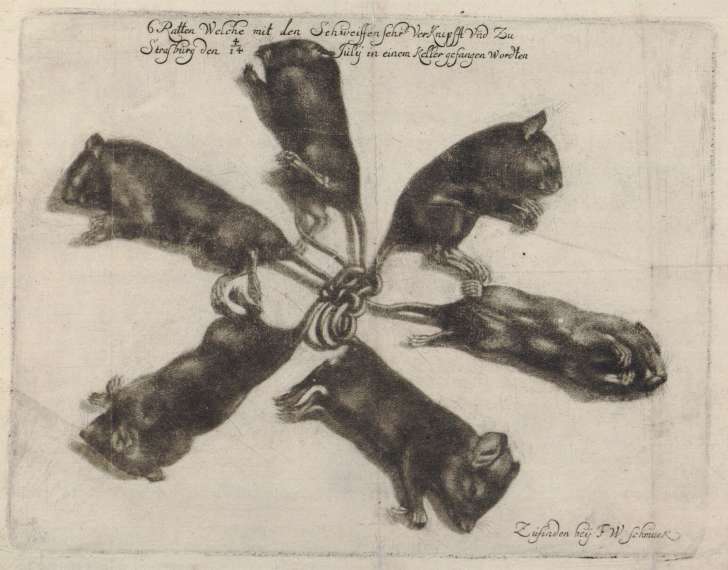Bugs and Beasts Before the Law
Part I
From “The Criminal Prosecution and Capital Punishment of Animals,” by E. P. Evans (1884)
It is said that Bartholomew Chassenée, a distinguished French jurist of the sixteenth century (born at Issy-l’Evêque in 1480), made his reputation at the bar as counsel for some rats, which had been put on trial before the ecclesiastical court of Autun on the charge of having feloniously eaten up and wantonly destroyed the barley-crop of that province. On complaint formally presented by the magistracy, the official or bishop’s vicar, who exercised jurisdiction in such cases, cited the culprits to appear on a certain day and appointed Chassenée to defend them.
In view of the bad repute and notorious guilt of his clients, Chassenée was forced to employ all sorts of legal shifts and chicane, dilatory pleas and other technical objections, hoping thereby to find some loophole in the meshes of the law through which the accused might escape, or at least to defer and mitigate the sentence of the judge. He urged, in the first place, that inasmuch as the defendants were dispersed over a large tract of country and dwelt in numerous villages, a single summons was insufficient to notify them all; he succeeded, therefore, in obtaining a second citation, to be published from the pulpits of all the parishes inhabited by the said rats. At the expiration of the considerable time which elapsed before this order could be carried into effect and the proclamation be duly made, he excused the default or non-appearance of his clients on the ground of the length and difficulty of the journey and the serious perils which attended it, owing to the unwearied vigilance of their mortal enemies, the cats, who watched all their movements, and, with fell intent, lay in wait for them at every corner and passage. On this point Chassenée addressed the court at some length, in order to show that if a person be cited to appear at a place, to which he cannot come with safety, he may exercise the right of appeal and refuse to obey the writ, even though such appeal be expressly precluded in the summons. The point was argued as seriously as though it were a question of family feud between Capulet and Montague in Verona or Colonna and Orsini in Rome.
[…]
Chassenée is said to have been employed in several cases of this kind, but no records of them seem to have been preserved, although it is possible that they may lie buried in the dusty archives of some obscure provincial town in France, once the seat of an ecclesiastical tribunal. The whole subject, however, has been treated by him exhaustively in a book entitled Consilium primum, quod tractatus jure dici potest, propter multiplicem et reconditam doctrinam, ubi luculenter et accurate tractatur quaestio illa: De excommunicatione animalium insectorum.
[…]
This curious dissertation originated, as it appears, in an an application of the inhabitants of Beaune to the ecclesiastical tribunal of Autun for a decree of excommunication against certain noxious insects called hubris or hurebers, probably a kind of locust or harvest-fly. The request was granted, and the pernicious creatures were duly accursed. Chassenée now raises the query whether such a thing may be rightfully and lawfully done […], and how it should be effected. “The principal question,” he said, “is whether one can by injunction cause such insects to withdraw from a place in which they are doing damage, or to abstain from doing damage there, under penalty of anathema and perpetual malediction. And although in times past there has never been any doubt on this point, yet I have thought that the subject should be thoroughly examined anew, lest I should seem to fall into the vice censured by Cicero […], of regarding things which we do not know as if they were well understood by us, and therefore rashly giving them our assent.” He divides his treatise into five parts, or rather discusses the subject under five heads: “First, lest I may seem to discourse to the populace, how are these our animals called in the Latin language; secondly, whether these our animals can be summoned; thirdly, whether they can be summoned by procurators, and, if they are cited to appear personally, whether they can appear by proxy, i.e., through procurators appointed by the judge who summons them; fourthly, what judge, whether layman or ecclesiastic, is competent to try them, and how he is to proceed against them and to pass and execute sentence upon them; fifthly, what constitutes an anathema and how does it differ from an excommunication.”
At a later period of his life Chassenée was reminded of the legal principle thus laid down and urged to apply it in favour of clients more worthy of its protection than a horde of vagrant rodents. In 1540 he was president of the judicial assembly known as the Parliament of Provence on a memorable occasion when the iniquitous measure for the extirpation of heresy by exterminating the Waldenses in the villages of Cabrières and Merindol was under discussion. One of the members of the tribunal, a gentleman from Arles, Renaud d’Alleins, ventured to suggest to the presiding officer that it would be extremely unjust to condemn these unfortunate heretics without granting them a hearing and permitting an advocate to speak in their defence, so that they might be surrounded by all the safeguards of justice, adding that the eminent jurist had formerly insisted upon this right before the court of Autun and maintained that even animals should not be adjudged and sentenced without having a proper person appointed to plead their cause. Chassenée thereupon obtained a decree from the king commanding that the accused Waldenses should be heard; but his death, which occurred very soon afterwards, changed the state of affairs and prevented whatever good effects might have been produced by this simple act of justice.
[…]
Sometimes the obnoxious vermin were generously forewarned. Thus the grand-vicars of Jean Rohin, Cardinal Bishop of Autun, having been informed that slugs were devastating several estates in different parts of his diocese, on the 17th of August, 1487, ordered public processions to be made for three days in every parish, and enjoined upon the said slugs to quit the territory within this period under penalty of being accursed. On the 8th of September, 1488, a similar order was issued at Beaujeu. The curates were charged to make processions during the offices, and the slugs were warned three times to cease from vexing the people by corroding and consuming the herbs of the fields and the vines, and to depart; “and if they do not heed this our command, we excommunicate them and smite them with our anathema.” In 1516, the official of Troyes pronounced sentence on certain insects […], which laid waste the vines, and threatened them with anathema, unless they should disappear within six days. Here it is expressly stated that a counsellor was assigned to the accused, and a prosecutor heard in behalf of the aggrieved inhabitants. As a means of rendering the anathema more effective, the people are also urged to be prompt and honest in the payment of tithes. Chassenée, too, endorses this view, and in proof of its correctness refers to Malachi, where God promises to rebuke the devourer for man’s sake, provided all the tithes are brought into the storehouse.
Check back for our next installment of Bugs and Beasts Before the Law, which you can also read in full here.

